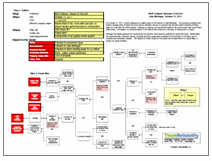By Kim Smiley
In order for a flight to take off and land safely, many complex mechanical systems have to work for the plane to function properly. Additionally, pilots need to be properly trained and proficient at their jobs. Airline processes also have to work in order to smoothly ticket, security screen and board all the passengers.
The number of things that have to work for a successful commercial airline flight is impressive. A recent incident highlighted that even the smallest hiccup, a broken bathroom lock for example, has the potential to cause big issues in the complex world of commercial flights.
 On November 18, 2011, a pilot accidentally got locked inside a bathroom just prior to landing at LaGuardia. This incident almost resulted in an emergency being declared and terrorist alert being issued. In order to understand this incident, a Cause Map can be built. A Cause Map is a visual root cause analysis that illustrates the cause and effect relationship between all the Causes that contribute to an event.
On November 18, 2011, a pilot accidentally got locked inside a bathroom just prior to landing at LaGuardia. This incident almost resulted in an emergency being declared and terrorist alert being issued. In order to understand this incident, a Cause Map can be built. A Cause Map is a visual root cause analysis that illustrates the cause and effect relationship between all the Causes that contribute to an event.
In this example, the copilot considered declaring an emergency because the pilot was gone from the cockpit longer than excepted and an unknown man with an accent knocked on the cockpit door. The copilot was concerned that this might be a potential hijacking attempt. His concern was caused by the intended destination being NYC and the 9/11 attacks that occurred there 10 years ago.
The pilot was taking longer than normal because the bathroom door lock had jammed when he had tried to exit after a bathroom break. The unknown man was a well-intended passenger who had heard the pilot calling for help. The pilot had given him the password to access the cockpit because all other crew members were inside the cockpit. There were two reasons that all other crew members were inside the cockpit. First, regulations require that at least 2 crew members are inside the cockpit at all times. Second this was a small airplane staffed with only 3 crew members. If the pilot or copilot needed to use the restroom, the only flight attendant had to enter the cockpit to meet the rules.
Luckily, the pilot was eventually able to free himself from the bathroom and return to the cockpit before anything too exciting happened. The plane landed as scheduled. The FBI and Port Authority cops met the plane, but after briefly talking to the passenger involved it was quickly determined that nothing suspicious had occurred.




